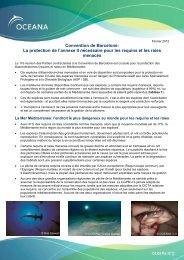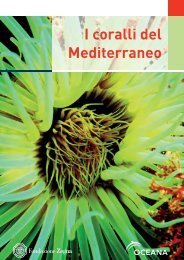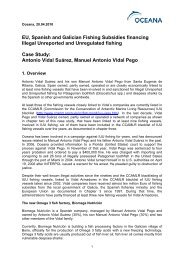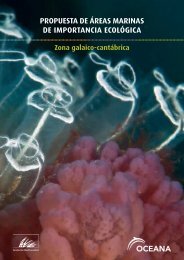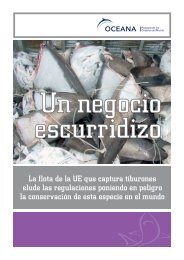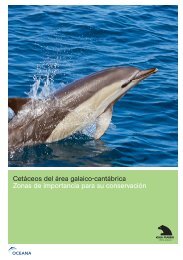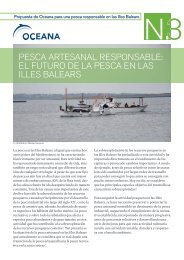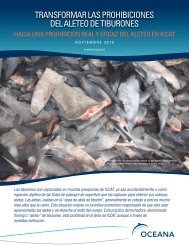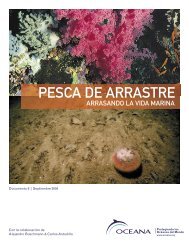Download - Oceana
Download - Oceana
Download - Oceana
Create successful ePaper yourself
Turn your PDF publications into a flip-book with our unique Google optimized e-Paper software.
DEEP- SEA SPONGE AGGREGATIONS<br />
OSPAR DEFINITION:<br />
According to the OSPAR background document “Case Report for the OSPAR List of threatened and/or<br />
declining species and habitats”, “Deep sea sponge aggregations” are mainly composed of sponges from<br />
two clases: Hexactinellida and Demospongia. They are known to occur between water depths of 250-<br />
1300 m, where the water temperature ranges from 4-10° C and there is moderate current velocity (0.5<br />
knots). Deep-sea sponge aggregations may be found on soft substrata or hard substrata, such as<br />
boulders and cobbles which may lie on sediment.<br />
Densities of occurrence are hard to quantify.<br />
Glass sponges (Hexactinellidae) and some desmonpongids such as Cladorhiza and Asbestopluma tend to<br />
be the predominant group of sponges in the deep sea. Other sponges that dominate some areas include<br />
Geodia barretti, G. macandrewi and Isops phlegraei. They can occur at very high densities.<br />
In the background document it is cited that dense aggregations of deep sponges are known to occur in the<br />
Porcupine Seabight, around the Faroe Islands and along the Norwegian coast up to West Spitzbergen and<br />
Bjornoya.<br />
OSPAR Regions where the habitat occurs: I, III, IV, V<br />
OSPAR Regions where such habitat is under threat and/or decline: V<br />
Habitat occurs within each of the following deep seabed EUNIS types:<br />
A6.62. Deep-sea sponge aggregations<br />
OCEANAS PROPOSALS:<br />
OCEANA has registered important sponge aggregations both in soft and hard substrata, from 35 to 475 m<br />
depth. In the IV and V regions the aggregations recorded occur only on hard bottoms; however in the<br />
Baltic Sea (Kattegat; region II) the aggregations that occur on soft bottoms are very important.<br />
We would like to hightligh that new scientific research is needed in order to gather new information related<br />
to the species that can form this habitat not only in the northern waters of the OSPAR maritime areas, but<br />
also in the southern part. OCEANA has recorded large areas dominated by Asconema setubalense in the<br />
south of Portugal and in the Gorrige Bank. Moreover, deep sea sponge aggregations made up of other<br />
different sponge species have also been recorded but we were not able to identify the species because of<br />
the lack of any sample. The evidence of of these sponge aggregations existence also shows that more<br />
research is needed in order to describe these better.<br />
In regions IV and V, fields of sponges at shallower waters than indicated in the background document are<br />
notably found; they can occupy large areas in the circalittoral zone. Despite these are not considered as<br />
deep- sea sponge aggregations, because they occupy shallower bottoms, its consideration on inclusion in<br />
the OSPAR List of endangered and/or declining species and habitats should be a good step to move<br />
towards its conservation. This is the case of aggregations of species such as Axinella spp., Artemisina<br />
transiens, Cliona celata or Phakellia ventilabrum.<br />
Due to technical restrictions, we can not give a relative density of each of the species aggregation that we<br />
have considered, but we give some qualitative descriptions of each of them.<br />
Taking into account the necessity to define and describe the various habitats that must be considered as<br />
50



